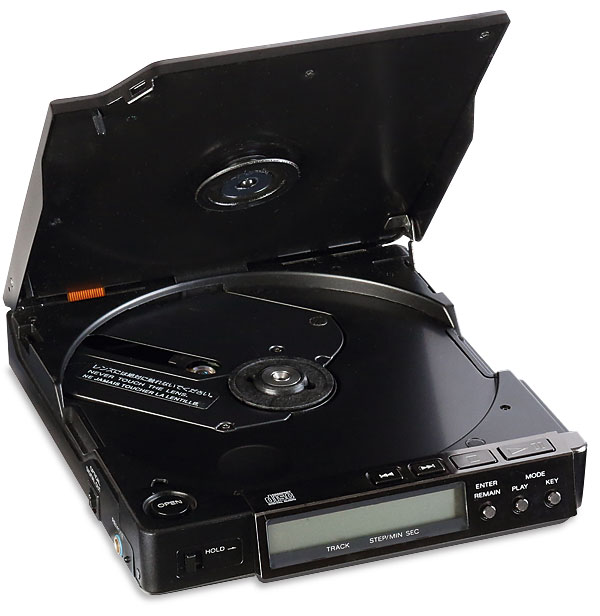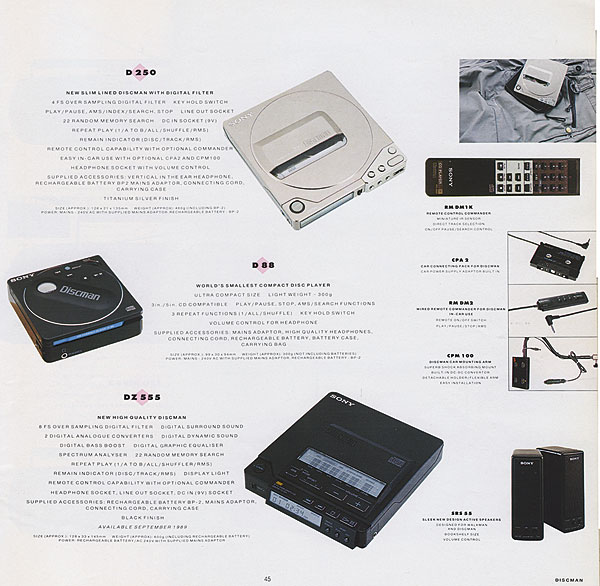Sony D-Z555 CD Portable Page 2
Otherwise the D-Z555 operates just like any other Discman player. The track programming sequence is as baffling as ever and the 'key mode' button remains. This switches the forward and back buttons between search and skip (Sony calls it AMS). I prefer the long/short press method for making this selection, which was in common use by this stage.
![]() Tim Listens
Tim Listens
If my description of the D-Z555 has you believing it's for gadget freaks only, then think again. With all the digital effects turned off it is a superb player, worthy of comparison with the best. The dual DACs overcome the last division between a portable and a serious machine. They clear the muddle and at last allow this little box to produce large, coherent soundstages filled with realistic-sounding instruments and voices. Also impressive is the smoothness of the midband; the hard and glassy sound for which some Japanese players are criticised is simply absent. The machine's real strength is that it sounds refined without being boring, polished without being dull. In many ways its presentation reminds me of the Technics SL-P1200 [HFN Aug '13] player, my long standing 1980s Japanese favourite.

Like the big Technics machine, this tiny portable majors on midband detail and clarity, putting space around the various sounds in a recording. It's difficult to conduct A/B tests because the D-Z555's line output level is lower than that of a full-sized player, but once you nudge the volume control up a few extra notches its strengths are clear.
Play Joan Armatrading's 'The Weakness In Me' [Track Record; A&M CDA 63725] and there is just enough sibilance in the sound to make it authentic, but not a hint of the brashness that marks down so many of the D-Z555's rivals. Solid centre presence and an unbroken spread of sound extending well beyond the speakers only served to confirm that there is more crammed into Sony's little box than is usual with portable players.

To hear Vivaldi's The Four Seasons, performed on instruments made by Antonio Stradivari [Philips 422 065-2], was another treat when played on the D-Z555. Strings often come over as wiry and thin if the equipment is not up to snuff, but here they sounded resonant and solid. Being critical, I felt there was perhaps a slight midband lift that emphasised an ultimate lack of richness in the bass, but this was a minor gripe set against the D-Z555's ability to pinpoint the spatial origin of each sound.
Grand Illusion
It's little details such as these that separate great components from the merely adequate. If your goal is equipment that 'disappears', leaving the illusion of a musical experience hanging in the air, the Sony D-Z555 (most surprisingly) is a very good place to start. It's just a shame so many of them must have spent their lives playing through a basic pair of headphones. While I admire the engineering of Sony's full-sized CD players I must admit that I'm not fully sold on their sound. To my ear, the early ones sound somewhat rough around the edges while the later designs are sterile and bland. This even includes big exotic machines such as the DVP-9000ES and SCD-777ES, both of which I've ultimately become frustrated with. The D-Z555 is not like that. If it were to be the only vintage CD player you owned, you wouldn't be missing out on much. For a pint-sized pocket portable that's an achievement.

Buying Secondhand
The D-Z555 is so highly regarded on the secondhand market that it's arguably the most valuable of all CD portables of this era. But among the genuinely nice examples is plenty of tired junk marked up at speculative prices. As ever with portables, be on the lookout for evidence of a previously hard life – knocks, scratches and the like. Be aware too that the lead acid battery packs will all be useless now and replacements are not available. This relegates any D-Z555 to static use, so make sure you get a power supply with it. In the UK the AC-930A is the correct one.
As regards faults, by far the most common is the seizure of the gears that drive the optical block along. The position it gets stuck in determines the exact symptoms, but in most cases the disc will turn but its contents will not be read. Normally everything can be freed off with careful dismantling, cleaning and reassembly but all the parts are tiny and difficult to access. It is a job for an expert really.

A piece of good news is that this model appears to have been made before Sony's problems with leaking SMT-type electrolytic capacitors, so there is no corrosive goo dissolving the PCB tracks to worry about here. That would all come later.
Hi-Fi News Verdict
It would seem from this showing that the Sony D-Z555 deserves its fine reputation and is the best of the Discmans. Well made and capable of matching the performance of a top-quality traditional player, it is the perfect example of the Japanese company's best trick – making something tiny that works better than its full-sized counterpart. Could this be the CD version of the WM-D6C Walkman Pro?


















































